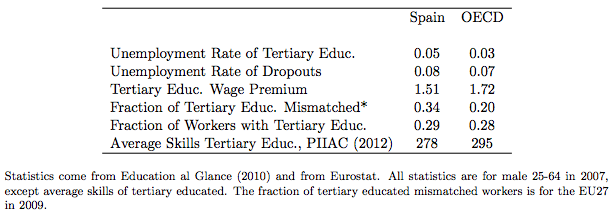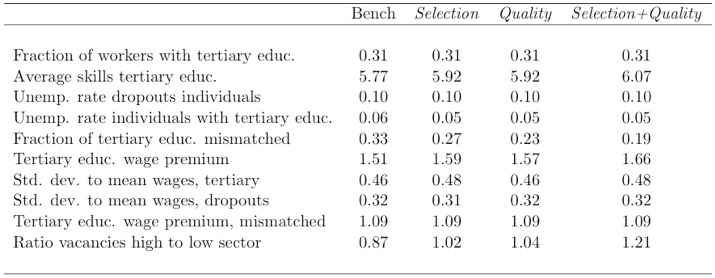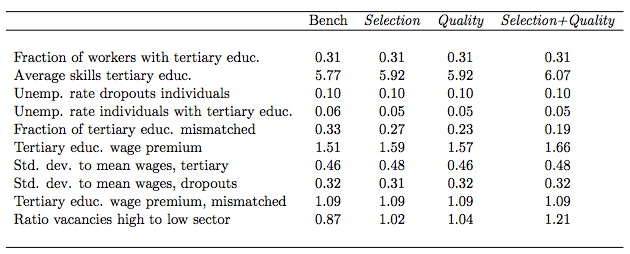Why do high school-educated Spaniards obtain a lower return on their education and experience higher occupational mismatch? In their BSE Working Paper (No. 807), “Education Policy, Occupation-Mismatch and the Skill Premium,” Francesc Obiols-Homs and Virginia Sánchez-Marcos explore the role of education policy in shaping the abilities of workers, and the effect of changing policies to improve labor market outcomes in Spain.
Unemployment in Spain compared to the OECD
For years prior to the start of the previous recession Spain had accomplished a reduction in its unemployment rates, matching those of high school graduates and dropouts in other OECD countries. But as table 1 below shows, the data hid worrisome statistics: a lower wage-premium and a high occupational mismatch for high school graduates (where a mismatch occurs when an educated individual works in a sector requiring less education than they possess).

What’s going on in Spain?
Based on evidence from the 2012 scores of the Programme for the International Assessment of Adult Competencies (PIAAC) and recent PISA scores, Obiols-Homs & Sanchez-Marcos propose that the quality of the educated labor force accounts for this oddity in the Spanish data. For example, the average PIAAC score for the high school educated in Spain is not only below the OECD average, but similar to the average score of middle school educated individuals in Sweden, Austria, and the Netherlands. Specifically the authors hypothesize that an education policy involves selecting individuals (by their innate ability level) and to increase their capacity to supply work (increase their labor productivity). With this view Obiols-Homs and Sánchez-Marcos posit that perhaps Spain poorly selects high-ability students into high school or has an overall poor ability in shaping the capacity of the population in high school – or even a combination of both.
The Effect of Alternate Policies
To test their hypothesis the authors propose a general equilibrium model that accounts for the ability types of individuals and education policy. They discipline their model by gauging its ability to reproduce the salient education and unemployment statistics in the pre-recession Spanish economy. Overall their model does pretty well at replicating the data and use this as a benchmark to analyze the outcome of several educational policy changes.
Table 2 below highlights the effects of changes to Spain’s education policy via the different channels the authors posit may be driving the lower statistics in Table 1. Selecting high ability types into high school (column 2) decreases the fraction of mismatched workers, while increasing their average skills and return to education via a higher wage premium, while other statistics (such as unemployment rates) remain at similar Spanish and OECD levels as seen in Table 1. There is also evidence that job vacancies in high tech sectors requiring educated high school graduates would increase relative to lower tech sectors (such as, and which the authors study further, housing construction). Improving high school education along the quality dimension reduces the mismatch still further (column 3). However, the policy outcome that best moves the Spanish labor market outcomes toward the OECD averages is in fact to improve both dimensions simultaneously, as seen in the final column. Further, the decreased mismatch is coincident with an increase in job vacancies for the better-educated high school graduates.

The Effect of the Housing Boom
The Spanish housing boom in the early 2000 may have had the unintended consequence of leading to misbehavior in the labor market. This may arise when a relatively productive low tech sector leads to educated individuals seeking employment in this sector and not the one in which their education would better fit (perhaps because of lower ability types, even with the education, leads to a greater expected opportunity in the low-tech sector). To study the effect of the housing boom on the Spanish labor market Obiols-Homs and Sánchez-Marcos reduce the productivity of the low-tech sector in their model by 5%.
The results, as shown in Table 3 below and in column 2, show that had there not been a housing boom in Spain the occupational mismatch would have been lower and closer to the OECD average. Returns to education via the wage premium would have been slightly higher along with a greater expansion of job offers in the higher-tech sector (as industries would have had incentives to switch).

Couple a high quality, selective education policy in the economy with no housing boom and the Spanish labor market outcomes look more like the OECD average in the wage premium and increased skills for the high school educated. Further, the results also yield an improvement over the OECD on occupational mismatch. However, removing the productivity from the low-tech sector accounted for by the housing boom comes with a draw back for dropouts, who now face a higher unemployment rate. Other researchers have found empirical evidence that between 1997 and 2007 Spain experienced a decrease in the returns to education and an increase in occupational mismatch. Reading table 3 leftwards from column 2 to the actual Spanish economy of column 1 confirms the empirical evidence. Obiols-Homs and Sánchez-Marcos conclude that the recent expansion of educational attainment in Spain could account for the lower returns to education via the wage premium and the higher occupational mismatch.
Can Spain get in line with the OECD?
Overall Obiols-Homs’ and Sánchez-Marcos’ analysis depicts the possibility of Spain gaining ground in labor market outcomes by shifting its educational policy. Moreover, the improvements are despite the occurrence of the housing boom. But further research may still be needed to consider education costs; or perhaps how changes in the quality of education compare with increasing the stringency of graduation requirements (such as meeting a minimal ability level). The virtue of the equilibrium analysis conducted here is that it points to education as the primary mechanism driving the observed outcomes of the Spanish labor market, and a path forward to tackling it.


